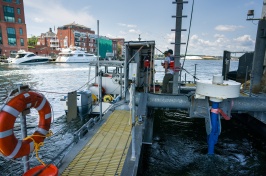NOAA, University of New Hampshire fund projects to investigate effects of chemical dispersants in oil spills

NOAA and the Coastal Response Research Center (CRRC) at the University of New Hampshire today announced research funding for three projects aimed at better understanding the impact of dispersed oil and chemical dispersants used during oil spills.
NOAA is awarding these grants using supplemental research funding provided by Congress as a result of the Deepwater Horizon oil spill. The grants, collectively totaling nearly $500,000, were awarded on a competitive basis through a peer-review process that attracted 36 proposals from U.S. and international research teams.
"The subject of dispersant use will intensify the next time there is a significant spill in U.S. waters, which is why continued research in this area is needed," said Doug Helton, incident operations coordinator for NOAA's Office of Response and Restoration.
"The Deepwater Horizon spill pointed to the gaps in our knowledge about dispersants. These grants aim tofill some of those gaps with scientific studies," said Nancy Kinner, professor of civil and environmental engineering and UNH director of the CRRC, which is a partnership between NOAA and UNH.
The funded projects, each to be completed within one year, are:
- University of Maryland Center for Environmental Science (Baltimore): $150,000 to study the effects of dispersants and dispersed oil on the commercially-important blue crab, a keystone species of the Gulf of Mexico and Atlantic coast, and its larvae. Principal investigator: Eric Schott.
- SEA Consulting Group (Cape Charles, Va.): $179,945 to study the role of social media and other communications tools in risk communication around dispersants and oil spills. Principal investigator: Ann Hayward Walker.
- Research Planning, Inc. (Columbia, S.C.): $149,938 to create an easily accessible database of all the data on the toxicological effects of dispersants and dispersed oil on marine organisms. Principal investigator: Adriana Bejarano.
 Â
Established in 2004, the CRRC is focused on developing new approaches to oil spill response and restoration in marine and estuarine environments through research and synthesis of information. The Center's mission is to: 1) conduct and oversee basic and applied research and outreach on spill response and restoration; 2) transform research results into practice; 3) serve as a hub for oil spill R&D; and 4) educate/train students who will pursue careers in spill response and restoration. For more information on these projects and on other CRRC-funded research, go to www.crrc.unh.edu. Â
The University of New Hampshire, founded in 1866, is a world-class public research university with the feel of a New England liberal arts college. A land, sea, and space-grant university, UNH is the state's flagship public institution, enrolling 12,200 undergraduate and 2,300 graduate students.
NOAA's mission is to understand and predict changes in the Earth's environment, from the depths of the ocean to the surface of the sun, and to conserve and manage our coastal and marine resources. Join us on Facebook, Twitter and our other social media channels.
Reporters and editors: Nancy Kinner, co-director of the NOAA/UNHCoastal Response Research Center, is available at 603-862-1422 or mailto:nancy.kinner@unh.edu"
Latest News
-
October 30, 2024
-
October 10, 2024
-
October 8, 2024
-
October 3, 2024
-
October 1, 2024
















































